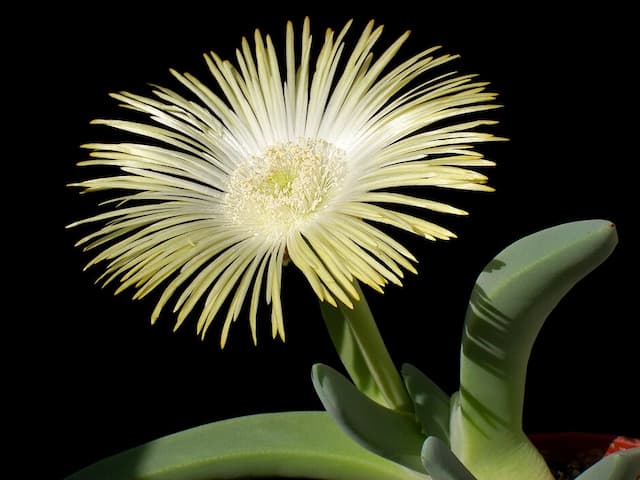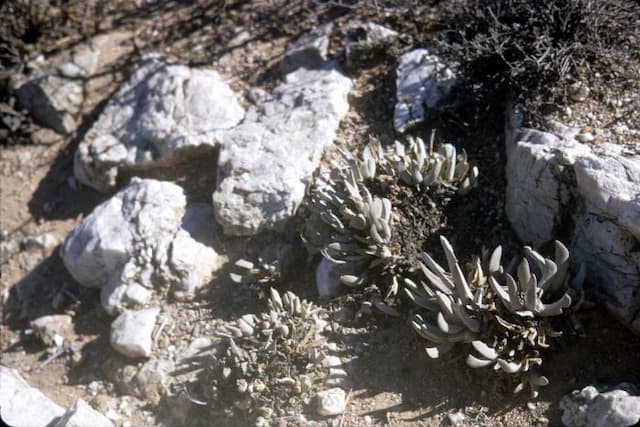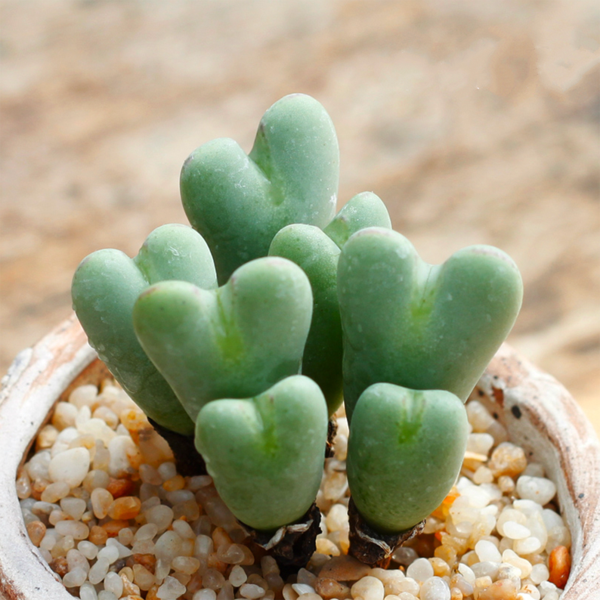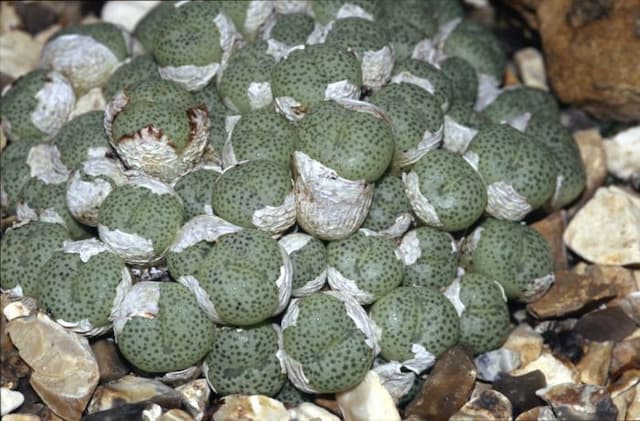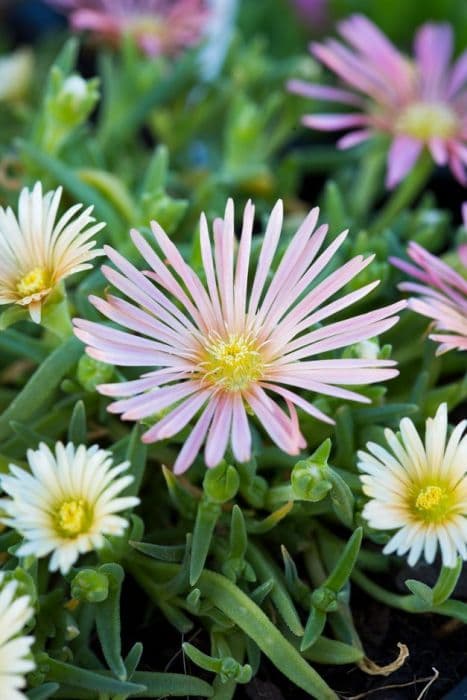Ice Plant Delosperma Mesa Verde = 'Kelaidis'

ABOUT
The Delosperma Mesa Verde, commonly known as the Ice Plant, is a striking succulent with a vibrant and colorful appearance. Its foliage consists of small, fleshy, and glossy leaves that form a dense mat. The leaves are typically green with a slightly bluish cast, creating a lush carpet-like effect. One of the most remarkable features of the Ice Plant is its daisy-like flowers, which bloom in a radiant shade of salmon-pink. These flowers are quite noticeable and boast a sunny center surrounded by delicate, narrow petals that can appear to shimmer in the sunlight. The blooms emerge in abundance, covering the foliage and creating a vivid display that can add a splash of color to any garden setting. The overall presence of the Ice Plant is one of hardiness and resilience, with its leaves and blooms adapting to flourish in a variety of conditions. Its succulent nature allows it to hold water within the leaves, giving them a plump, juicy appearance. The contrasts of the green to bluish foliage and the warm-toned flowers make the Delosperma Mesa Verde a beautiful and striking addition to rock gardens, ground covers, and borders, offering year-round interest and a generous blooming season.
About this plant
 Names
NamesFamily
Aizoaceae
Synonyms
Mesa Verde Ice Plant, Kelaidis Ice Plant
Common names
Delosperma 'Kelaidis'
 Toxicity
ToxicityTo humans
The plant commonly known as Ice Plant (Delosperma Mesa Verde 'Kelaidis') is not known to be toxic to humans. There are no widely recognized symptoms of poisoning from ingesting this plant, as it is generally considered safe. However, it is always advisable to avoid eating ornamental plants due to potential individual allergies or unknown reactions.
To pets
The Ice Plant (Delosperma Mesa Verde 'Kelaidis') is not known to be toxic to pets. No symptoms of poisoning are typically expected if pets ingest this plant. It is deemed safe for pets, but as with humans, it's generally recommended to prevent pets from eating plants that are not intended for consumption to avoid any possible gastrointestinal upset or allergic reactions.
 Characteristics
CharacteristicsLife cycle
Perennials
Foliage type
Evergreen
Color of leaves
Green
Flower color
Pink
Height
0.2 feet (6 cm)
Spread
2 feet (60 cm)
Plant type
Succulent
Hardiness zones
5
Native area
South Africa
Benefits
 General Benefits
General Benefits- Drought Tolerance: The plant is highly resistant to drought, making it ideal for xeriscaping and arid environments.
- Ground Cover: Delosperma Mesa Verde spreads out to form a dense carpet that helps prevent soil erosion and suppresses weed growth.
- Low Maintenance: It requires minimal care beyond initial establishment, with no need for frequent watering or fertilizing.
- Cold Hardy: It is able to withstand colder temperatures than many other succulents, making it suitable for a range of climates.
- Attracts Pollinators: The vibrant flowers attract bees, butterflies, and other beneficial pollinators to the garden.
- Decorative: With its bright flowers and succulent foliage, it adds aesthetic appeal to rock gardens, borders, and container displays.
- Heat Resistance: The plant thrives in hot conditions without wilting or burning, ideal for sunny, exposed locations.
 Medical Properties
Medical PropertiesThis plant is not used for medical purposes.
 Air-purifying Qualities
Air-purifying QualitiesThis plant is not specifically known for air purifying qualities.
 Other Uses
Other Uses- Ground Cover Alternative: Delosperma Mesa Verde, commonly known as Ice Plant, can be used as a vibrant ground cover in rock gardens or xeriscaped areas, providing dense coverage that reduces soil erosion.
- Crevice Filler: Its spreading habit makes Ice Plant ideal for planting in crevices of stone walls or pathways, where it adds color and texture.
- Living Mulch: Ice Plant can serve as a living mulch, helping to retain soil moisture and suppress weed growth under taller, drought-tolerant ornamental plants.
- Container Gardening: Due to its compact size, Ice Plant is well-suited for use in container gardens, adding a spillover effect with its succulent foliage and flowers.
- Green Roofing: Ice Plant's drought tolerance and shallow rooting system make it a suitable choice for green roofing projects in arid climates.
- Rooftop Gardens: Its resilience to heat and sunlight makes Ice Plant a decorative and practical option for rooftop gardens, providing visual interest and aiding in temperature regulation for the building below.
- Butterfly Attraction: Planting Ice Plant in gardens can attract butterflies, adding an ecological benefit by supporting local pollinator populations.
- Seasonal Interest: With blooms that open in the sunshine, Ice Plant adds unexpected bursts of seasonal interest to perennial borders and succulent collections.
- Erosion Control on Slopes: The trailing habit of Ice Plant helps to stabilize slopes and embankments, mitigating against soil erosion with its mat-forming growth.
- Craft Projects: Drought-resistant Ice Plant can be used in outdoor craft projects, like living wreaths or table centerpieces, holding up well in hot, dry conditions.
Interesting Facts
 Feng Shui
Feng ShuiIce Plant is not used in Feng Shui practice.
 Zodiac Sign Compitability
Zodiac Sign CompitabilityIce Plant is not used in astrology practice.
 Plant Symbolism
Plant Symbolism- Resilience: Known as Ice Plant, it symbolizes resilience due to its ability to thrive in harsh, drought-prone environments.
- Survival: Ice Plant's skill in conserving water reflects the symbolism of survival in difficult conditions.
- Bright Outlook: The vibrant flowers of the Ice Plant can signify a positive and bright outlook on life's challenges.
- Adaptability: As an Ice Plant can adapt to various soil types and climates, it often represents flexibility and adaptability in life.
 Water
WaterThe Ice Plant should be watered sparingly since it is drought tolerant and prone to root rot if overwatered. During the active growing season in spring and summer, watering every two weeks should suffice, ensuring the soil is allowed to dry out between waterings. Approximately one gallon per plant should be used each time you water. In the fall and winter, reduce watering frequency as the plant enters dormancy. Always check the soil moisture before watering to ensure it is not damp.
 Light
LightIce Plants thrive best in full sunlight conditions where they can receive at least six hours of direct sun daily. The ideal spot for an Ice Plant is in a south-facing location that's free of shade for most of the day. They are well adapted to bright and sunny environments, reflecting their natural habitat.
 Temperature
TemperatureIce Plants prefer temperate environments and do best between 40°F and 90°F. They can withstand short periods of frost but consistently cold temperatures below 20°F may harm the plant. The ideal temperature range for Ice Plants is within 60°F to 80°F.
 Pruning
PruningIce Plants should be pruned to remove dead or wilted flowers and encourage new growth. Light pruning in the early spring can help maintain shape and vigor. Pruning right after the first bloom cycle can also promote a second bloom in the same season. The best time for pruning is after the last frost in spring or early summer.
 Cleaning
CleaningAs needed
 Soil
SoilThe best soil mix for Ice Plant (Delosperma Mesa Verde) is a well-draining mix, such as a combination of cactus potting soil with perlite or pumice. The soil pH should be neutral to slightly acidic, around 6.0 to 7.5.
 Repotting
RepottingIce Plant (Delosperma Mesa Verde) should be repotted every 2-3 years or when it outgrows its current pot, preferably in the spring or early summer.
 Humidity & Misting
Humidity & MistingIce Plant (Delosperma Mesa Verde) prefers low to moderate humidity levels and is tolerant of dry air conditions, making it suitable for arid and semi-arid climates.
 Suitable locations
Suitable locationsIndoor
Place in bright light, keep soil dry between watering.
Outdoor
Full sun, well-drained soil, tolerate droughts, minimal care.
Hardiness zone
5-10 USDA
 Life cycle
Life cycle'Kelaidis', commonly known as the Mesa Verde ice plant, begins its life as a seed planted in well-draining soil in spring after the danger of frost has passed. Germination occurs with adequate moisture and warmth, leading to the emergence of small seedlings. These seedlings grow into succulent plants that spread out to form a mat-like ground cover, with fleshy leaves storing water for dry periods. Throughout spring and into summer, the Mesa Verde ice plant produces bright salmon-pink flowers that attract pollinators and set seeds for the next generation. Over the summer, the plant continues to grow, storing energy in its leaves and roots. In winter, the plant enters dormancy, where growth slows down or stops until temperatures rise again in spring, completing its annual cycle.
 Propogation
PropogationPropogation time
Spring-Summer
The Ice Plant, Delosperma Mesa Verde 'Kelaidis', can be effectively propagated by taking stem cuttings. This method is most successfully undertaken in the spring or early summer when the plant is actively growing. To propagate, select a healthy stem and cut a piece approximately 2 to 4 inches long (5 to 10 cm). Allow the cut end of the stem to callous over for a day or two to prevent rotting when planted. Then, plant the stem cutting in well-draining soil and water it lightly. Keep the soil consistently moist but not waterlogged as the cutting establishes roots. New growth will indicate successful propagation, after which care can be similar to that of a mature plant.
